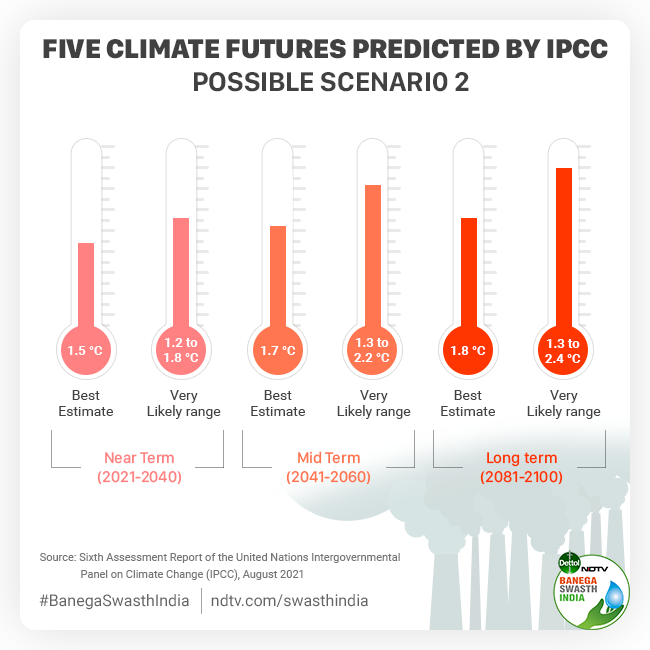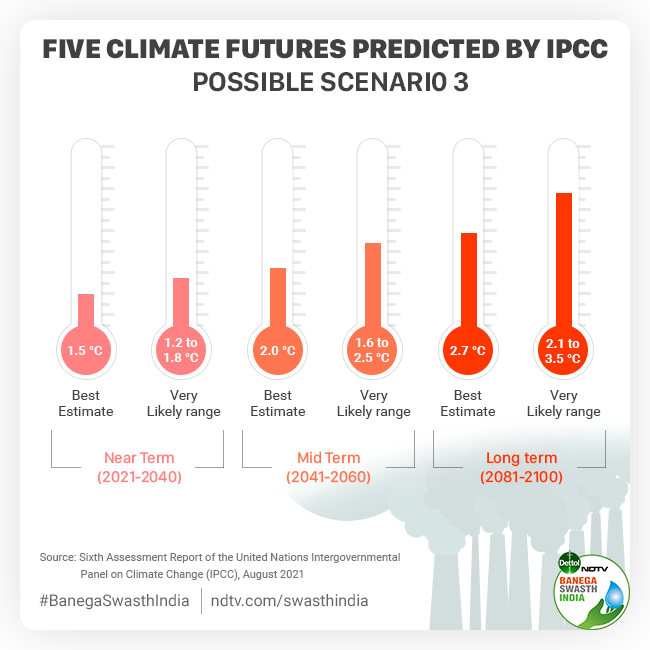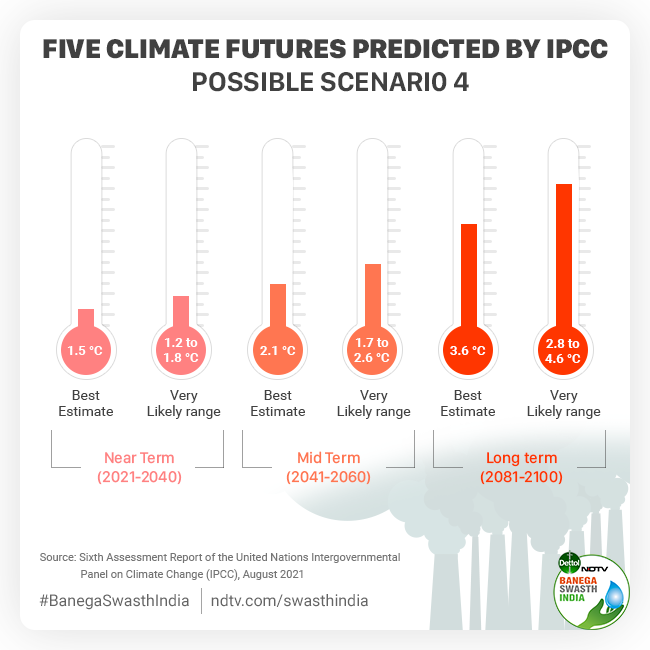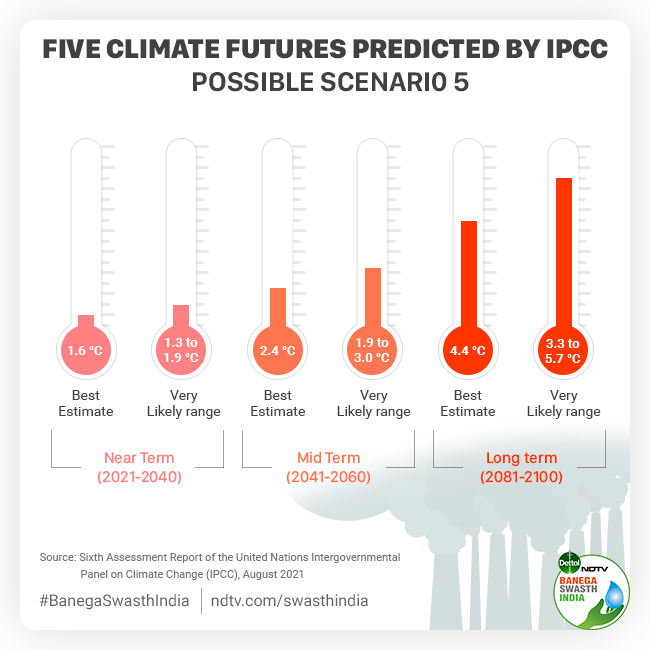Highlights
- In its 6th assessment report, IPCC talks about 5 possible futures
- If CO2 emission double by 2050, warming may rise by 5.7°C by 2100: IPCC
- Developed countries will have to phase out fossil fuels faster than others
New Delhi: According to scientists, for the past 2,000 years, global surface temperatures stayed relatively constant until an unprecedented rate of warming began in the mid-20th century because of the human activities for economic growth and exploitation of fossil fuel. Now, the planet’s average temperature is about 1.1 degrees more than that in 1850–1900, the period from which the observational temperature records are available, as per the United Nation’s Intergovernmental Panel on Climate Change (IPCC). According to NASA’s The Goddard Institute for Space Studies, the average global temperature during the late 1800s was about 13.7 degrees Celsius, today it is around 14.8 degrees Celsius. The United Nations has said on multiple occasions that because of this rise in warming, various countries across the globe have been experiencing extreme weather events like extreme rainfalls, floods, droughts, forest fires, landslides, diseases outbreaks among others causing massive damage to lives and livelihoods of the people and resulting in acute food and drinking water shortages.
Also Read: World Facing COVID-19, Fragility, Conflict, Climate Change; We’re At Turning Point: UNGA
Experts say that while the world has crossed 1.1 degrees Celsius rise in global temperature, it should not surpass the 1.5 degrees Celsius mark ever in order to prevent even more intense and devastating consequences of the climate crisis. It has warned of unimaginable destruction due to heat and sea-level rise worldwide in the coming years if the nations continue to emit carbon at current levels and global warming continues. Therefore, in 2016, 191 countries signed the Paris Agreement, also called the Paris Climate Accord promising that they will carry out climate actions to pursue efforts to not let the temperature of the Earth rise above 1.5 degrees Celsius from the pre-industrial times ever in the future.
While talking to NDTV, Chandra Bhushan, environment and climate change expert and CEO of International Forum for Environment, Sustainability and Technology said,
The global average temperature at the end of the century will be determined by the amount of greenhouse gas emissions over the next several decades. As many countries are still developing using fossil fuels as the main source of energy, greenhouse gases are bound to release for economic growth to take place. But this needs to be restricted by phasing out fossil fuels and adopting cleaner sources of energy because, with rising global warming, we will struggle to breathe clean air, for water and food. It threatens the core of existence, apart from the constant threat from floods, droughts, cyclones and disease outbreaks. So, this is the promise that the counties made as they signed the Paris Agreement- to restrict their emissions. The developed countries must phase out fossil fuels by 2035-2040, at a much faster rate than others. Developing countries like India will have a breathing space of few years but ultimately the world as a whole need to phase out fossil fuels in the next three decades.
IPCC in its latest assessment report has raised the alarm that the countries are failing to meet the goal promised in the Paris Agreement and issued a “code red” warning to humanity projecting a massive loss of lives and livelihoods.
To further warn about the consequences of human actions and negligence, IPCC has talked about five possible scenarios for the future. According to Mr Bhushan, it is important to understand these scenarios as these provide roadmaps for the policies, research and activism for the years to come. Each of the scenarios or the Shared Socioeconomic Pathway (SSP) provide narratives to explore possible future both with regards to socio-economic development and climate pathways. Along with social and economic forces that drive greenhouse gas emissions, land use, climate mitigation, and air pollution, these scenarios also take into consideration natural factors like solar activity and volcano eruptions.
The IPCC report has highlighted that as the world heads towards 1.5 degrees Celsius warming, there will be an increasing occurrence of extreme weather events which are unprecedented in the observational record. It added that with every additional 0.5 degrees Celsius warming there will be a visible increase in intensity and frequency of hot extremes, including heatwaves, extremely heavy rain events as well as agricultural and ecological droughts– a period with abnormal soil moisture deficit, which happens due to rain deficit and excess evapotranspiration.
Also Read: Opinion: Climate Change Is A Healthcare Emergency
Possible Climate Future 1: Labeled as SSP1-1.9, this is IPCC’s most optimistic scenario. It describes a world where global carbon dioxide emissions are cut to net-zero by 2050 which means that the world is able to achieve a balance between the greenhouse gases put into the atmosphere and those taken out. The temperature rise predicted under this scenario is 1.2-1.7 degrees Celsius by 2040, 1.2-2.0 degrees Celsius by 2060 and 1-1.8 degrees Celsius by 2100.
For this, the IPCC says that the pathways that the societies need to follow include switching to more sustainable practices, with the focus shifting from economic growth to overall well-being. Investments in education and health need to go up and inequality must decrease. In this scenario, extreme weather would become more common, but together, the world would avoid the worst impacts of climate change.
According to D. Raghunandan, scientist, Delhi Science Forum, the Paris agreement targets to meet this scenario of keeping global warming to around 1.5 degrees Celsius above preindustrial temperatures, with warming hitting 1.5 degrees Celsius and then dipping back down and stabilizing around 1.4 degrees Celsius by the end of the century.
Possible Climate Future 2: Labeled as SSP1-2.6, the next-best scenario predicted by IPCC says that global carbon dioxide emissions are cut severely, but not as fast as required. It would reach net-zero after 2050. This scenario imagines the same socioeconomic pathways towards sustainability as in the first scenario. The temperature rise predicted under this scenario is 1.2-1.8 degrees Celsius by 2040, 1.3-2.2 degrees Celsius by 2060 and 1.3-2.4 degrees Celsius by 2100.
According to Mr Raghunandan, under this scenario with each decimal point increase in temperature, extreme climate events will become more frequent, villages and cities on the coastline across the globe will submerge due to rising sea levels. It will become increasingly difficult for humanity to reverse the damage done to the environment, he said.
Possible Climate Future 3: Labeled as SSP2-4.5, IPCC calls it a ‘middle of the road’ scenario. Under this scenario, the carbon dioxide emissions are the same as the current levels before starting to fall around mid-century but do not reach net-zero by 2100. The temperature rise predicted under this scenario is 1.2-1.8 degrees Celsius by 2040, 1.6-2.5 degrees Celsius by 2060 and 2.1-3.5 degrees Celsius by 2100.
According to IPCC, in this scenario, the socioeconomic pathways make no notable shifts, the progress towards sustainability is slow, with development and income growing unevenly.
Because of greenhouse gas emissions, the Arctic will continue to warm more than global surface temperature at double the rate of global warming, according to IPCC. Some mid-latitude and semi-arid regions, and the South American Monsoon region, are projected to see the highest increase in the temperature of the hottest days. Extremely heavy rainfall events will intensify and become more frequent in most regions, the IPCC highlighted.
Possible Climate Future 4: Labeled as SSP3-7.0, in this scenario, the temperatures rise steadily, doubling carbon emissions from the current levels by 2100. This scenario imagines countries becoming more competitive with one another, shifting toward national security and ensuring their own food supplies. The temperature rise predicted under this scenario is 1.2-1.8 degrees Celsius by 2040, 1.7-2.6 degrees Celsius by 2060 and 2.8-4.6 degrees Celsius by 2100.
According to IPCC, at the global scale, extreme daily rain events are projected to intensify by about 7 per cent for each one degree Celsius of global warming. The proportion of intense category cyclones will increase, ocean temperature and acidity will rise and the Arctic is likely to be to melt further and be practically sea ice-free in September at least once before 2050.
Possible Climate Future 5: Labeled as SSP5-8.5, this is a future that IPCC warns the world to avoid at all costs. It imagines the current carbon dioxide emissions levels to roughly double by 2050. While the global economy grows significantly, it is fueled by exploiting fossil fuels and energy-intensive lifestyles. The temperature rise predicted under this scenario is 1.3-1.9 degrees Celsius by 2040, 1.9-3.0 degrees Celsius by 2060 and a scorching 3.3-5.7 degrees Celsius by 2100.
This scenario warns that without rapidly cutting carbon dioxide emissions to net-zero levels, the world is headed for over 5 degrees Celsius hotter world with more frequent weather extremes, and dangerous disruptions in the climate including the world’s ability to grow crops.
Commenting on the five possible futures predicted by the IPCC, Mr Bhushan said,
The possible future scenarios predicted by IPCC are of various temperature increases that can happen because of greenhouse gases emission. These projections are based on complex calculations of the physical science of climate systems and are considered to be highly accurate. These calculations also capture socioeconomic changes in areas such as population, urban density, education, land use and wealth. IPCC’s predicted futures of Earth’s climate are very important to understand as these give us the path to take, to deal with economic growth and greenhouse gas emissions. So, if we are moving quickly to renewable energy and to net zero-emission technologies, we will be able to control temperature. If we are not able to do it and continue to rely on fossil fuel, then the temperature of the Earth can increase by more than 5 degrees Celsius by 2100.
Also Read: U.N. Says World Likely To Miss Climate Targets Despite COVID Pause In Emissions
NDTV – Dettol have been working towards a clean and healthy India since 2014 via Banega Swachh India initiative, which is helmed by Campaign Ambassador Amitabh Bachchan. The campaign aims to highlight the inter-dependency of humans and the environment, and of humans on one another with the focus on One Health, One Planet, One Future – Leaving No One Behind. It stresses on the need to take care of, and consider, everyone’s health in India – especially vulnerable communities – the LGBTQ population, indigenous people, India’s different tribes, ethnic and linguistic minorities, people with disabilities, migrants, geographically remote populations, gender and sexual minorities. In wake of the current COVID-19 pandemic, the need for WASH (Water, Sanitation and Hygiene) is reaffirmed as handwashing is one of the ways to prevent Coronavirus infection and other diseases. The campaign will continue to raise awareness on the same along with focussing on the importance of nutrition and healthcare for women and children, fight malnutrition, mental wellbeing, self care, science and health, adolescent health & gender awareness. Along with the health of people, the campaign has realised the need to also take care of the health of the eco-system. Our environment is fragile due to human activity, that is not only over-exploiting available resources, but also generating immense pollution as a result of using and extracting those resources. The imbalance has also led to immense biodiversity loss that has caused one of the biggest threats to human survival – climate change. It has now been described as a “code red for humanity.” The campaign will continue to cover issues like air pollution, waste management, plastic ban, manual scavenging and sanitation workers and menstrual hygiene. Banega Swasth India will also be taking forward the dream of Swasth Bharat, the campaign feels that only a Swachh or clean India where toilets are used and open defecation free (ODF) status achieved as part of the Swachh Bharat Abhiyan launched by Prime Minister Narendra Modi in 2014, can eradicate diseases like diahorrea and the country can become a Swasth or healthy India.
[corona_data_new]


























